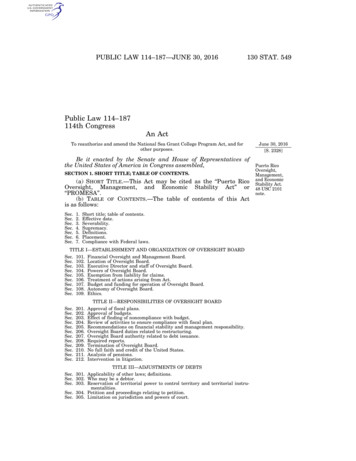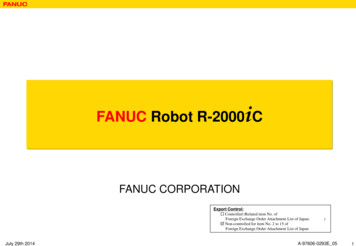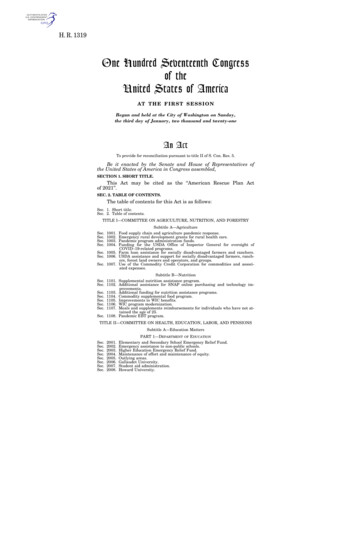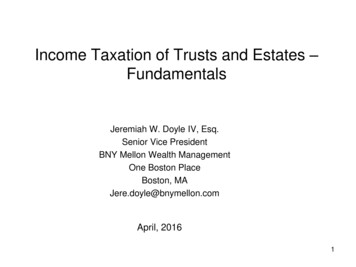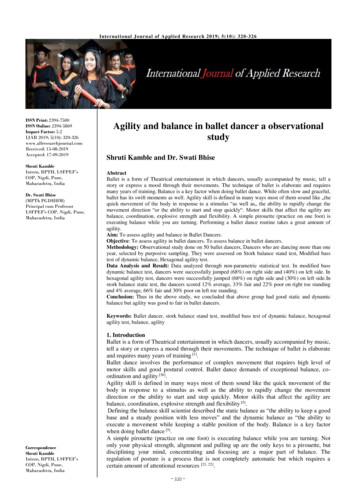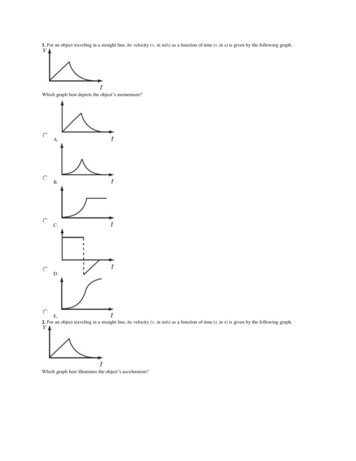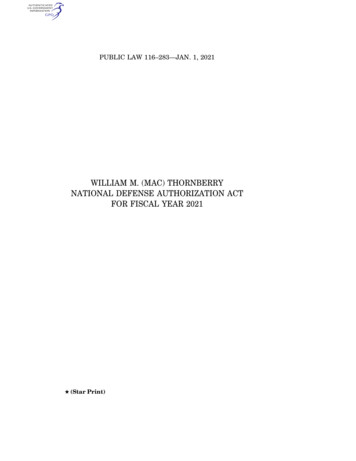
Transcription
Refinitiv US SEF LLC3 Times Square, New York, NY 10036T 646 223 7397www.refinitiv.comMarch 24, 2020Vanessa CountrymanSecretary of the CommissionU.S. Securities and Exchange Commission100 F Street, NEWashington, DC 20549Re:File No. S7–24–15: Use of Derivatives by Registered Investment Companies andBusiness Development Companies; Required Due Diligence by Broker-Dealers andRegistered Investment Advisers Regarding Retail Customers’ Transactions in CertainLeveraged/Inverse Investment VehiclesDear Ms. Countryman:FX Alliance LLC (“FXall”) and Refinitiv US SEF LLC1 (“Refinitiv SEF” and, togetherwith FXall, “Refinitiv”) welcome the opportunity to submit comments on the Securities andExchange Commission’s (“SEC” or “Commission”) proposed rule on Use of Derivatives byRegistered Investment Companies and Business Development Companies; Required DueDiligence by Broker-Dealers and Registered Investment Advisers Regarding Retail Customers’Transactions in Certain Leveraged/Inverse Investment Vehicles (the “Proposed Rule”).2Refinitiv appreciates the importance of the Proposed Rule to the SEC’s investorprotection mandate under section 18 of the Investment Company Act of 1940 (“ICA”) in light ofthe fact that many registered investment companies and business development companies(collectively, “funds”) utilize derivatives for various purposes. We believe, however, that theProposed Rule’s blunt, one-size-fits-all approach fails to appropriately distinguish certainderivatives instruments in the foreign exchange (“FX”) asset class that do not present the risks tofund investors that are the underlying drivers of the Proposed Rule and Section 18 of the ICA. Assuch, we believe the Proposed Rule would inappropriately limit a fund advisor’s ability to usethese FX instruments to manage risk for the fund and its investors, and that a more tailoredapproach is required instead.Accordingly, Refinitiv respectfully requests that any final rule adopted by theCommission exclude FX forwards, FX swaps, non-deliverable forwards involving FX (“NDFs”),and FX options (collectively, “FX Derivatives”) from the definition of “derivatives transaction”1In October 2018, the Financial and Risk business of Refinitiv, of which Thomson Reuters (SEF) LLC (“TR SEF”)was a part, changed its name to Refinitiv in connection with a partial acquisition of the Financial and Risk business.As of February 28, 2019, TR SEF formally changed its name and is now doing business as Refinitiv US SEF LLC.2Use of Derivatives by Registered Investment Companies and Business Development Companies; Required DueDiligence by Broker-Dealers and Registered Investment Advisers Regarding Retail Customers’ Transactions inCertain Leveraged/Inverse Investment Vehicles, Proposed Rule, 85 Fed. Reg. 4446 (Jan. 24, 2020).1
based on the distinctive nature of such instruments and the risk-mitigating purposes for whichthey are used by funds.3I.Refinitiv’s Background and Interest in the Proposed RuleRefinitiv is a global provider of financial markets data and infrastructure. Subsidiarycompanies of Refinitiv are leaders in (among other things) various segments of the FX market.Our FXT solutions provide access to liquidity in OTC markets, trade execution capabilities andconnections for market participants worldwide. They also offer post-trade services globally,enabling banks, brokers and electronic marketplaces to connect seamlessly with theircounterparties. Refinitiv therefore offers comprehensive solutions for trade discovery andanalysis, execution and post-trade services.FXall operates an electronic trading, execution, trade processing and negotiation systemfor FX spots, forwards, and other FX instruments. FXall’s trading system facilitates competitivepricing, internal trading controls, risk management and a granular audit trail. It has succeeded inimproving efficiency and transparency, and reducing risk for important FX markets to the USand the world economy. As a result, today a large part of the FX market is traded on electronicsystems such as FXall—including less liquid or infrequently traded instruments customized byend-users to meet specific commercial requirements.Refinitiv SEF is registered as a swap execution facility (“SEF”) with the CommodityFutures Trading Commission (the “CFTC”), and currently facilitates electronic trading in NDFsand FX options. Refinitiv SEF enables its market participants to trade NDFs and FX optionsthrough its request-for-quote system and an order book.II.FX Products Should Be Excluded from the “Derivatives Transaction” DefinitionThe Proposed Rule would clarify and expand the existing limitations and requirementsapplicable to a fund’s use of “derivatives transactions,” which largely stem from a variety ofSEC guidance and no-action letters. The rationale for these restrictions is to address the risk thatfunds would engage in undue speculation through derivatives transactions, and that they wouldnot have assets sufficient to cover their obligations arising from those transactions.4 TheProposed Rule highlights these concerns by referencing examples where funds experienced rapidlosses in part due to their derivatives exposure.We appreciate these concerns, but assert that FX Derivatives do not implicate the sametheoretical dangers, nor were they the cause of any of the examples cited by the Commission asgrounds for imposing the proposed limitations and requirements. This is because FX Derivativeshave limited exposure to market fluctuations, short durations, and entail no material counterpartyor settlement risk. This is particularly true for FX forwards and FX swaps, as described furtherbelow.3Refinitiv also requests that any final rule include rule text directly excluding purchased options (such as FXoptions) from the definition of a “derivatives transaction.” Although this appears to be the Commission’s intent,which we support, this should be stated in rule text rather than discussed in the narrative preamble.4See, e.g., Proposed Rule, 85 Fed. Reg. at 4451-52.2
Refinitiv therefore requests that FX Derivatives be clearly and expressly excluded fromthe definition of a “derivatives transaction” in any final rule on the subject. Below, we addresseach type of FX Derivative, in turn.A.The Proposed Rule Fails to Appropriately Consider the DistinguishingCharacteristics of FX Forwards and FX SwapsFX forwards and FX swaps5 are qualitatively different from typical derivatives, and wetherefore believe the Proposed Rule should treat these products differently. Importantly, unliketypical swaps or futures contracts, each counterparty to an FX forward or FX swap knows itsultimate liability at the time of execution. Additionally, under the Commission’s Release 10666(i.e., the Commission’s statement of policy regarding the application of Section 18 of the ICA tocertain types of transactions), FX forwards and FX swaps are not “leveraged,” and therefore donot raise the types of concerns that are the focus of the Proposed Rule. Specifically, Release10666 states that “[l]everage exists when an investor achieves the right to a return on a capitalbase that exceeds the investment which he has personally contributed to the entity or instrumentachieving a return.”6 FX forwards and FX swaps do not satisfy this definition because theyrequire each party to deliver the full notional amount of the transaction at maturity.(i) The Treasury DeterminationLargely for the reasons described above, Congress, the US Department of Treasury(“Treasury”), the Commission and the CFTC determined to exempt FX forwards and FX swapsfrom nearly all regulations otherwise applicable to swaps. Specifically, pursuant to authoritygranted by the Congress in the Dodd-Frank Act, the Secretary of the Treasury issued adetermination (the “Determination”) that FX forwards and FX swaps should not be regulated asswaps under the regulatory regime enacted as part of Title VII of the Dodd-Frank Act.7In the Determination, Treasury explained that FX forwards and FX swaps involve “asimple exchange of principal at one point in time and [for FX swaps] a reversal of that exchangeat some later date.”8 As a result, the amount of the exchange by each party is known at the onsetof the transaction. Because payment obligations in FX forward and FX swap transactions arefixed at the start of the contract, these payment obligations, in contrast to those for other types of5For purposes of this comment letter, we refer to FX forwards and FX swaps as defined in the Dodd-Frank Act.Specifically, an FX forward is “a transaction that solely involves the exchange of 2 different currencies on a specificfuture date at a fixed rate agreed upon on the inception of the contract covering the exchange,” and an FX swap is(generally speaking) a combination of two FX forwards. See Dodd-Frank Act § 721(a)(2). See Sections 1a(24)-(25)of the Commodity Exchange Act (“CEA”), 7 U.S.C. §§ 1a(24)-(25). See also rule 3a69-2(c)(3)-(4) under theSecurities Exchange Act of 1934 (“Exchange Act”); rule 1.3 under the CEA (sub-section (3) of the “swap”definition).6See Securities Trading Practices of Registered Investment Companies, Investment Company Act Release No.10666 (Apr. 18, 1979) [44 Fed. Reg. 25128 (Apr. 27, 1979)], at n.5 (‘‘Release 10666’’).7Determination of Foreign Exchange Swaps and Foreign Exchange Forwards under the Commodity Exchange Act,77 Fed. Reg. 69694 (Nov. 20, 2012).8Determination, 77 Fed. Reg. at 69702.3
derivatives, are insulated from market fluctuations.9 In addition, most FX forward and FX swaptransactions are short-term transactions, with tenors generally less than one year—and often lessthan seven days.10Based on these significant differences in the characteristics of FX forwards and FX swapsas compared to other types of derivatives, Treasury concluded that these transactions: (1) “carrysignificantly lower levels or counterparty credit risk [and market risk], relative to other swapsand derivatives;”11 and (2) bear primarily settlement risk, which is “virtually eliminate[ed]” byvirtue of the settlement arrangements used for these transactions.12 Specifically, theDetermination found that:o FX forwards and FX swaps are subject to less counterparty credit risk than otherderivatives because of the short average length of the contracts;13o Because FX forwards and FX swaps settle physically and payment obligations arefixed at the start of the contract, risk associated with the products is largely settlementrisk;14o Settlement risk for these transactions, though, has been addressed through the“extensive use of payment versus payment (“PVP”) settlement arrangements;”15 ando Through the use of PVP arrangements, approximately 75 percent of the entire foreignexchange market settles without settlement risk to either party.16Based on these findings, Treasury determined that FX forwards and FX swaps are“qualitatively different from other classes of swaps,”17 and it concluded and that they should notbe regulated as swaps. And, as a result of this Determination by Treasury, pursuant to rulesjointly adopted by the Commission and the CFTC, FX forwards and FX swaps are notconsidered to be swaps.189Id. at 69696-97. Furthermore, foreign exchange rates, upon which the risk of an FX forward or FX swap is based,historically have been less volatile (and thus less risky) than other underlying markets such as equities.10Refinitiv concurs with, and supports, the comments submitted on March 28, 2016, by the Foreign ExchangeProfessionals Association (“FXPA Letter”). The FXPA Letter cites data demonstrating that a significant portion ofFX forward and FX swap transactions have tenors less than seven days, with the vast majority having tenors of lessthan one year. FXPA Letter at 3; see also Determination, 77 Fed. Reg. at 69697.11Determination, 77 Fed. Reg. at 69697.12Id. at 69698.13Id.14Id. at 69697-8.15Id at 69698.16Id.17See Dodd-Frank Act § 722(h).18Further Definition of “Swap,” “Security-Based Swap,” and “Security-Based Swap Agreement”; Mixed Swaps;Security-Based Swap Agreement Recordkeeping, 77 Fed. Reg. 48208 (Aug. 13, 2012) (“Joint Product Definitions4
Just as these distinctive characteristics of FX forwards and FX swaps persuaded Treasurythat they should not be considered swaps generally subject to the swap regulatory regime of theDodd-Frank Act, so, too, they demonstrate that the Commission should not consider them to be“derivatives transactions” subject to the restrictions and requirements imposed on funds’ use ofderivatives. Because of their fixed and known payment obligation and short duration, FXforwards and FX swaps do not pose the types of risk identified in the Proposed Rule that areassociated with other types of derivatives—i.e., a risk of undue speculation causing a fund tosuffer substantial and unforeseeable losses that, through the effects of leverage, render the fundunable to meet its obligations without a forced sale of other investments.19The risks that FX forwards and FX swaps present to funds that trade them are limited,and, importantly, those risks are manageable. To subject them to the limitations and regulatoryrequirements set forth in the Proposed Rule, which are designed to address the risk to fundinvestors from highly-leveraged and longer-term derivatives, is unwarranted.Accordingly, just as the Commission (and the CFTC) concluded on the basis of theDetermination by Treasury that FX forwards and FX swaps should be excluded from the class ofswaps subject to regulation under the Dodd-Frank Act, the Commission similarly shouldconclude that they should be excluded from the class of derivatives subject to VaR-basedlimitations and regulatory requirements when used by funds.(ii) The Dreyfus No-Action LetterWe believe the Commission’s current regime with regard to FX forwards and FX swapsfully addresses any exposure funds have to such instruments by requiring segregation of the fullnotional amount. Specifically, in its no-action letter to Dreyfus Strategic Investing and DreyfusStrategic Income (the “Dreyfus no-action letter”), the Commission stated that “if a fund entersinto a long, physically settled forward contract, and the contract specifies the forward price thatthe fund will pay at settlement, the fund would, consistent with staff positions, segregate thisforward/contract price.”20This requirement (i.e., for full segregation) eliminates any risk to the fund associated withengaging in undue speculation, or failing to have sufficient assets to cover the fund’s obligations.Moreover, there is no possibility that market swings could cause a fund to have greater-thanexpected exposure to an FX forward or FX swap, because the delivery obligation is known at thetime of execution.Rules”). See rule 3a69-2(c)(1) under the Exchange Act; rule 1.3(xxx)(3)(i) under the CEA. Although FX forwardsand FX swaps thus are excluded from the definition of the terms “swap” and “security-based swap,” theynevertheless remain subject to the reporting requirements and business conduct standards under the Dodd-Frank Act.See rule 3a69-2(c)(2) under the Exchange Act and rule 1.3(xxx)(3)(ii) under the CEA.19See, e.g., Proposed Rule, 85 Fed. Reg. at 4453. In this manner, FX forwards and FX swaps differ from a currencyswap which, as stated in the Determination, “generally involves a periodic exchange of a floating amount of cashflows between the counterparties based on the value of the underlying variable(s) on which the derivative contract isbased.” Determination, 77 Fed. Reg. at 69702. The fixed nature of a fund’s exposure under an FX forward or FXswap transaction distinguishes it from an exposure to floating metrics underlying derivatives such as currencyswaps. For the avoidance of doubt, this letter is not addressing currency swaps.20Dreyfus Strategic Investing and Dreyfus Strategic Income, SEC Staff No-Action Letter (June 22, 1987).5
We therefore request that, if the Commission does not exclude FX forwards and FXswaps from the definition of a “derivatives transaction” entirely, it codify the policy described inthe Dreyfus no-action letter. Specifically, the Commission could explicitly require fundsengaging in FX forwards and FX swaps to segregate the full notional amount associated withsuch transactions without subjecting such funds to the VaR-based limitations, risk managementrequirements or Board oversight and reporting requirements set forth in the Proposed Rule.B.The Proposed Rule Fails to Appropriately Consider the DistinguishingCharacteristics of NDFsNDFs likewise should be excluded from the definition of a “derivatives transaction”because they are economically and functionally the same as FX forwards (as defined in theDodd-Frank Act).21 The sole difference between these two transactions is that in an FX forward,the trade closes out at maturity upon delivery by each party to the transaction of the grossamount of the respective currency specified in the contract. In comparison, in an NDF, the tradecloses out at maturity upon delivery of the net value of the underlying exchange, denominated ina pre-determined currency. For example, parties to an FX forward may exchange US dollars for,say, British pounds, and in an NDF the paying party pays the difference between the agreedupon exchange rate for two currencies (e.g., US dollars/Brazilian real) and the spot rate atsettlement. In each structure, the net value transferred would be the value difference between thetwo currencies exchanged.NDFs often exist because of capital controls imposed by certain emerging markets thatmake FX forwards impossible—and not because of any greater benefit or leverage associatedwith NDFs. NDFs are used almost exclusively when one of the underlying currencies cannot bephysically delivered or is, as a practical matter, not deliverable offshore as a matter of local lawor other local requirements. Non-deliverability is a feature of many emerging market currencies,such as the Brazilian real and Argentine peso. As the Federal Reserve Bank of New Yorkexplained, “Major NDF market trading began in the early 1990’s, initially as a means forcompanies to hedge their exposure to currency fluctuations of emerging market countries withactual or potential foreign exchange convertibility restrictions.”22 The use of NDFs for thispurpose has continued, as evidenced by the fact that “NDF markets in currencies of countriesthat have allowed increased capital convertibility, to the point where currency hedging is fullyavailable onshore, have dissipated and/or disappeared.”23 This further demonstrates that NDFsand FX forwards are functionally equivalent to one another.21The Determination did not consider whether NDFs should be considered swaps because the Dodd-Frank Act onlygave Treasury the authority to exempt FX forwards and FX swaps. See Dodd-Frank Act §§ 721(a)(2), 722(h).Similarly, in the Joint Product Definitions Rules, the Commission and the CFTC concluded only that NDFs do notfall within the “plain language in the definition of the term ‘foreign exchange forward’” in the Dodd-Frank Act. SeeJoint Product Definitions Rules, 77 Fed. Reg. at 48256. We recognize that NDFs are not FX forwards. But that is adifferent question than whether funds that trade NDFs should be subject to the restrictions and limitations as set outin the Proposed Rule, given that NDFs are functionally and economically indistinguishable from FX forwards. Forthe reasons presented in text, they should not.22Laura Lipscomb, “Federal Reserve Bank of New York, An Overview of Non-Deliverable Foreign ExchangeForward Markets,” at 2 (May 2005) (“Fed NDF Overview”).23Id.6
NDFs are a key component of FX markets in non-deliverable currencies, as FX forwardsare not capable of being executed in those markets (or, in some markets, it is sufficientlyimpractical to physically deliver the local currency that would be traded on a forward basis).Indeed, for non-deliverable currencies, an NDF is the only viable means by which to effect aforward transaction. And, just like FX forwards, NDFs typically are of a short duration andmature in much less time than many other types of derivatives.24 Virtually all mature in one yearor less, and over 90% of volumes are transacted in tenors of three months or less.25To be sure, FX forwards involve an exchange of the paired currencies at maturity,whereas NDFs involve a net payment in a specified currency based on spot exchange rates atmaturity. However, the distinction between physical settlement in FX forwards and netsettlement in NDFs should not be determinative with respect to the issue of limitations andrestrictions on funds’ ability to make use of these instruments. NDFs essentially are FX forwardswhere the currency itself is non-deliverable. NDFs bear the same key economic characteristics asFX forwards—short duration, limited exposure to market fluctuations, and no materialcounterparty or settlement risk. Were one to simultaneously enter into an FX forward and anNDF with identical underlying currencies, notional amount and maturity date, the value of thetransactions would be identical throughout their tenor.The CFTC and the European Securities Markets Authority (“ESMA”) have recognizedthe low-risk profile of NDFs, as compared to other derivatives such as interest rate and creditdefault swaps, as they both have declined to impose a clearing mandate for NDFs pursuant to theDodd-Frank Act. The discussion during a meeting of the CFTC’s Global Markets AdvisoryCommittee regarding a possible clearing mandate for NDFs noted “the very short date[d] natureof this market.”26 And in response to its consultation on the question, ESMA received commentsstating that the average interbank maturity of NDFs is “short, around one or two months,” andcharacterized by “reduced volatility” because “most FX rates on which NDFs trades are basedare heavily managed or influenced by Central Bank activity.”27As with FX forwards, the risks of derivatives trading identified in the Proposed Rule—that a fund might amass through undue speculation an exposure that, over an extended period oftime, imperils its ability to meet its obligations in the regular course of its operations—are notpresent for NDFs as with other types of derivatives. In failing to account for these fundamentaldifferences in the characteristics of NDFs, as with FX forwards, the Proposed Rule paints withtoo broad a brush. NDFs, like FX forwards, should be excluded from the definition of a“derivatives transaction” in any final rulemaking.24See Sangita Misra and Harendra Behera, “Non Deliverable Foreign Exchange Forward Market: An Overview,” at30 (Winter 2006) (“for most of the [Asian NDF] currencies, there is limited liquidity in contracts with a maturityover one year.”).25See CFTC Foreign Exchange Markets Subcommittee Memorandum to CFTC Global Markets AdvisoryCommittee, Response to request for recommendation on an FX NDF mandate, at 3 (Dec. 5, 2014), available /documents/file/gmac fxndfmandate122214.pdf.26See Transcript, Global Markets Advisory Committee, at 50 (Oct. 9, 2014) (statement of Chris Allen, Barclays),available at ocuments/file/gmac 100914 transcript.pdf.27See Reply form for the Consultation Paper on the Clearing Obligation under EMIR (no. 3), Asociacion deMercados Financieros, at 8, available at en W-Dx5KYd.7
C.The Proposed Rule Should Clarify its Exclusion for Purchased Options, andFails to Appropriately Consider the Distinguishing Characteristics of OtherFX OptionsFX options traded on Refinitiv’s electronic platform are limited-risk instruments. Like theother FX Derivatives discussed herein, they are also short-term transactions. Most havematurities less than one month, and virtually all have maturities less than one year. The risk ofsuch instruments can be effectively managed by a fund’s advisor without the broad-brush VaRbased limits and regulatory requirements that the Proposed Rule would impose on longer-dated,more highly leveraged, and riskier derivatives instruments.Indeed, the preamble discussion in the Proposed Rule indicates that the Commission doesnot intend for purchased options to fall within the definition of a “derivatives transaction.”28Refinitiv agrees, but believes that this conclusion is not necessarily apparent from the text of theproposed definition of the term “derivatives transaction” itself.29 We urge the Commission toexclude purchased options (including FX options) directly in the rule text itself, rather thanaddressing the issue through non-contiguous passages in the lengthy preamble discussion.We also urge the Commission to exclude written “covered calls” from the definition ofthe term “derivatives transaction.” A fund that writes (i.e., sells) a call option receives paymentof a premium from the holder (i.e., the purchaser) of the option, and in return must deliver theunderlying asset at a pre-agreed price if the holder exercises the option. Such a call option thuswould fall within the “derivatives transaction” definition under the Proposed Rule.However, a fund that writes a covered call option owns the security or other assetunderlying the option, thereby eliminating its downside risk. Because the delivered asset is in thefund’s inventory, the covered call is a riskless financial obligation to the fund. Given that thefund’s obligation under the call option is covered by its ownership of the asset to be delivered,writing the option cannot be considered undue speculation, nor does it present the concern thatthe fund will have to dispose of investments to meet its obligations under the call option as existswith respect to highly-leveraged derivatives instruments. Accordingly, since the concernsaddressed by the ICA are not present in a covered call, these options should be excluded from thedefinition of a “derivatives transaction” that is subject to the Proposed Rule.D.The Proposed Rule Should Entirely Exempt FX Derivatives Used forHedging PurposesAsset managers rely upon FX Derivatives to mitigate commercial risk associated withtheir investment strategies, specifically with respect to short-term fluctuations in foreign28See, e.g., Proposed Rule, 85 Fed. Reg. at 4456 (“A derivative that does not impose any future payment obligationon a fund generally resembles a securities investment that is not a senior security, in that it may lose value but willnot require the fund to make any payments in the future.”).29The text of the proposed definition refers both to options, and also to derivatives instruments under which a fund“may be required to make any payment or delivery of cash or other assets.” Any final rule text should be clear thatthis language does not encompass purchased options.8
currency values.30 FX Derivatives therefore play a critical role in facilitating access to globalmarkets (and, in the case of NDFs, to certain emerging markets in particular) for funds and theirinvestors.We therefore appreciate the Commission’s decision to propose an exception from certainof the proposed requirements for funds that use derivatives solely for currency hedging purposes,because the Commission’s prior proposed rule on the subject did not contain any such exception.However, the proposed exception extends only to funds that solely use derivatives to hedgecurrency risk, and would require that derivatives instruments be tied to “specific hedgedinvestments (foreign-currency-denominated securities held by the fund).”31We believe these limitations are ill-advised and will have little benefit in practice. First,we do not believe there is any policy reason to restrict funds from relying on this exception ifthey use derivatives for hedging and non-hedging purposes. A fund that uses some derivativesfor investment purposes and FX Derivatives for hedging purposes is still merely hedging itscurrency risk with its FX Derivatives. Such a fund should not be required to subject those FXDerivatives to the proposed VaR-based limitations and other proposed requirements, when afund that enters into the same FX Derivatives without the derivatives for investment purposescould rely on the Commission’s proposed exception.Second, limiting the proposed exception to hedges that are directly tied to foreigncurrency-denominated securities held by a fund is too narrow to be useful. For example, a fundcould wish to hedge foreign currency risk associated with incoming payment streams through theuse of FX Derivatives, which would not satisfy this requirement. Additionally, though, hedgesare often imperfect (as the Commission noted32), so any requirement that hedges be strictlyrelated to specific securities already held by the fund may be impractical to comply with.To the extent that the Commission is concerned that a broader hedging exception wouldmake it difficult to confirm compliance, we respectfully disagree. Government regulations thataccount for (and provide exemptions or exceptions associated with) hedging activity are commonin a variety of contexts. Indeed, the Commission itself has set hedging standards before. Forexample, in further defining the term “major security-based swap participant” pursuant toauthority granted under the Dodd-Frank Act, the Commission (jointly with the CFTC) adopted anew rule specifically defining the phrase “hedging or mitigating commercial risk.” The rule setsforth a general definition, and then specifically identifies certain security-based swap positionsthat, “[d]epending on the applicable facts and circumstances . . . may be expected” to fall withinthat general definition. These include positions established to manage equity or market risk in30In the Determination, Treasury noted that FX forwards and FX swaps are “predominantly used as a source offunding to hedge risk associated with short-term fluctuations in foreign currency values and to manage global cashflow needs.” Determination, 77 Fed. Reg.
o Settlement risk for these transactions, though, has been addressed through the "extensive use of payment versus payment ("PVP") settlement arrangements;"15 and o Through the use of PVP arrangements, approximately 75 percent of the entire foreign exchange market settles without settlement risk to either party.16

